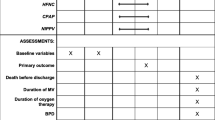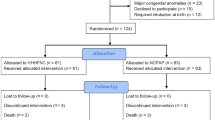Abstract
Despite the paucity of evidence, the practice of weaning nasal continuous positive airway pressure (NCPAP) is widespread. However, the most clinically effective non-invasive ventilatory support strategy remains to be determined. We compared the outcome of very premature infants with respiratory distress syndrome treated with a combination of NCPAP and heated humidified high-flow nasal cannula (HHFNC) versus NCPAP and low-flow nasal cannula (LFNC). Between 2004 and 2008, patients ≤28 weeks of gestation and <1,250 g of birth weight were treated with NCPAP + HHFNC or NCPAP + LFNC. Their respiratory and non-respiratory outcome including cost-effectiveness was compared after matching for antenatal steroid doses, mode of delivery, birth plurality, gestational age, birth weight, gender, surfactant doses, length of mechanical ventilation and clinical risk index for babies-II (CRIB-II) score. Thirty-nine infants received HHFNC + NCPAP, and 40 received NCPAP + LFNC. Median gestational age and birth weight were 27 weeks and 930 g and 27 weeks and 980 g, respectively. The total number of NCPAP days was significantly reduced by 50 % in the HHFNC group. Thirteen percent of the patients on NCPAP suffered from nasal bridge lesions compared to none on HHFNC. Respiratory and non-respiratory outcome was not significantly different otherwise. Combination of NCPAP and HHFNC reduced costs by 33 %. Conclusions: HHFNC shortens NCPAP time without increasing overall length of non-invasive respiratory support in very preterm infants. Unlike NCPAP, HHFNC does not seem to increase the risk of nasal trauma and appears to improve cost-effectiveness whilst producing otherwise equal respiratory and non-respiratory outcomes.
Similar content being viewed by others
Abbreviations
- RDS:
-
Respiratory distress syndrome
- NCPAP:
-
Nasal continuous positive airway pressure
- HHFNC:
-
Heated humidified high-flow nasal cannula
References
Abdel-Hady H, Shouman B, Aly H (2011) Early weaning from CPAP to high flow nasal cannula in preterm infants is associated with prolonged oxygen requirement: a randomized controlled trial. Early Hum Dev 87(3):205–208
Alsop EA, Cooke J, Gupta SK, Sinha SK (2008) Nasal trauma in preterm infants receiving nasal continuous positive airway pressure. Arch Dis Child 93(S2):n23
Carlo WA (2012) Gentle ventilation: the new evidence from the SUPPORT, COIN, VON, CURPAP, Colombian Network, and Neocosur Network trials. Early Hum Dev 88(S2):S81–S83
Centers for Disease Control and Prevention (CDC) (2005) Update: Ralstonia species associated with Vapotherm oxygen delivery devices—United States. MMWR Morb Mortal Wkly Rep 54(43):1286–1287
Cockburn F, Cooke RWI, Gamsu HR, Greenough A, Hopkins A, McIntosh N, Ogston SA, Parry GJ, Silverman M, Shaw JCL, Tarnow-Mordi WO, Wilkinson AR (1993) The CRIB (clinical risk index for babies) score: a tool for assessing initial neonatal risk and comparing performance of neonatal intensive care units. Lancet 342:193–198
Courtney SE, Pyon KH, Saslow JG, Arnold GK, Pandit PB, Habib RH (2001) Lung recruitment and breathing pattern during variable versus continuous flow nasal continuous positive airway pressure in premature infants: an evaluation of three devices. Pediatrics 107:304–308
De Klerk A (2008) Humidified high-flow nasal cannula: is it the new and improved CPAP? Adv Neonatal Care 8(2):98–106
De Paoli AG, Lau R, Davis PG, Morley CJ (2005) Pharyngeal pressure in preterm infants receiving nasal continuous positive airway pressure. Arch Dis Child Fetal Neonatal Ed 90:79–81
Fischer C, Bertelle V, Hohlfeld J, Forcada-Guex M, Stadelmann-Diaw C, Tolsa JF (2010) Nasal trauma due to continuous positive airway pressure in neonates. Arch Dis Child Fetal Neonatal Ed 95(6):F447–F451
Fisher & Paykel Healthcare Ltd. (2010) Optiflow™. Auckland, www.fphcare.com/userfiles/file/RH/BrochureDownloads/Nurturing%20Life.pdf, accessed 15 Aug 2011
Holleman-Duray D, Kaupie D, Weiss MG (2007) Heated humidified high-flow nasal cannula: use and a neonatal early extubation protocol. J Perinatol 27:776–781
Jardine LA, Inglis GD, Davies MW (2011) Strategies for the withdrawal of nasal continuous positive airway pressure (NCPAP) in preterm infants. Cochrane Database Syst Rev 16(2), CD006979
Kernick J, Magarey J (2010) What is the evidence for the use of high flow nasal cannula oxygen in adult patients admitted to critical care units? A systematic review. Aust Crit Care 23(2):53–70
Kliegman RM, Fanaroff AA (1984) Necrotizing enterocolitis. N Engl J Med 310:1093
Kopelman AE (2003) Airway obstruction in two extremely low birthweight infants treated with oxygen cannulas. J Perinatol 23(2):164–165
Kubicka ZJ, Limauro J, Darnall RA (2008) Heated, humidified high-flow nasal cannula therapy: yet another way to deliver continuous positive airway pressure? Pediatrics 121(1):82–88
Lampland AL, Plumm B, Mayers PA, Worwa CT, Mammel MC (2009) Observational study of humidified high-flow nasal cannula compared with nasal continuous positive airway pressure. J Pediatr 154:177–182
Locke RG, Wolfson MR, Shaffer TH, Rubenstein SD, Greenspan JS (1993) Inadvertent administration of positive end-distending pressure during nasal cannula flow. Pediatrics 91(1):135–138
Myers TR (2002) AARC Clinical Practice Guideline: selection of an oxygen delivery for neonatal and pediatric patients—2002 revision and update. Respir Care 47(6):707–716
Parry G, Tucker J, Tarnow-Mordi WO for the UK Neonatal Staffing Study Collaborative Group (2003) CRIB II: an update of the clinical risk index for babies score. Lancet 361:1789–1791
Saslow JG, Aghai ZH, Nakhla TA, Hart JJ, Lawrysh R, Stahl GE, Pyon KH (2006) Work of breathing using high-flow nasal cannula in preterm infants. J Perinatol 26:476–480
Shoemaker M, Pierce MR, Yoder BA, DiGeronimo RJ (2007) High flow nasal cannula versus nasal CPAP for neonatal respiratory disease: a retrospective study. J Perinatol 27:85–91
Sreenan C, Lemke RP, Hudson-Mason A, Osiovich H (2001) High-flow nasal cannulae in the management of apnea of prematurity: a comparison with conventional nasal continuous positive airway pressure. Pediatrics 107:1081–1083
Todd DA, Wright A, Broom M, Chauhan M, Meskell S, Cameron C, Perdomi AM, Rochefort M, Jardine L, Stewart A, Shadbolt B (2010) Methods of weaning preterm babies <30 weeks gestation off CPAP: a multicentre randomized controlled trial. Arch Dis Child Fetal Neonatal Ed 97(4):F236–F240
Vapotherm, Inc (2008) Vapotherm® 2000. Stevensville, www.vtherm.com/_pdfs/Operating%20Manual_2000i_RevE%2006.pdf, accessed 15 Aug 2011
Volpe JJ (2001) Intracranial hemorrhage: germinal matrix-intraventricular hemorrhage or the premature infant. In: Volpe JJ (ed) Neurology of the newborn, 4th edn. Saunders, Philadelphia, pp 428–493
Waugh JB, Granger WM (2004) An evaluation of two new devices for nasal high-flow gas therapy. Respir Care 94(8):902–906
Wilkinson D, Andersen C, O'Donnell CP, De Paoli AG (2011) High flow nasal cannula for respiratory support in preterm infants. Cochrane Database Syst Rev 11(5), CD006405
Wilkinson AR, Haines L, Head K, Fielder AR (2008) UK retinopathy of prematurity guideline. Early Hum Dev 84(2):71–74
Woodhead DD, Lambert DK, Clark JM, Christensen RD (2006) Comparing two methods of delivering high-flow gas therapy by nasal cannula following endotracheal extubation: a prospective randomised, masked, crossover trial. J Perinatol 26:481–485
Acknowledgements
The authors would like to thank Prof. Anne Greenough, Department of Neonatology, King's College Hospital, London, UK; and Tracy Coelho (Paediatric Registrar), Patricia Walker (Neonatal Secretary), and Sue Clayton (Clinical Librarian), Department of Neonatology, Brighton and Sussex University Hospitals NHS Trust, Brighton, UK.
Conflict of interest
None
Author information
Authors and Affiliations
Corresponding author
Rights and permissions
About this article
Cite this article
Fernandez-Alvarez, J.R., Gandhi, R.S., Amess, P. et al. Heated humidified high-flow nasal cannula versus low-flow nasal cannula as weaning mode from nasal CPAP in infants ≤28 weeks of gestation. Eur J Pediatr 173, 93–98 (2014). https://doi.org/10.1007/s00431-013-2116-2
Received:
Accepted:
Published:
Issue Date:
DOI: https://doi.org/10.1007/s00431-013-2116-2




